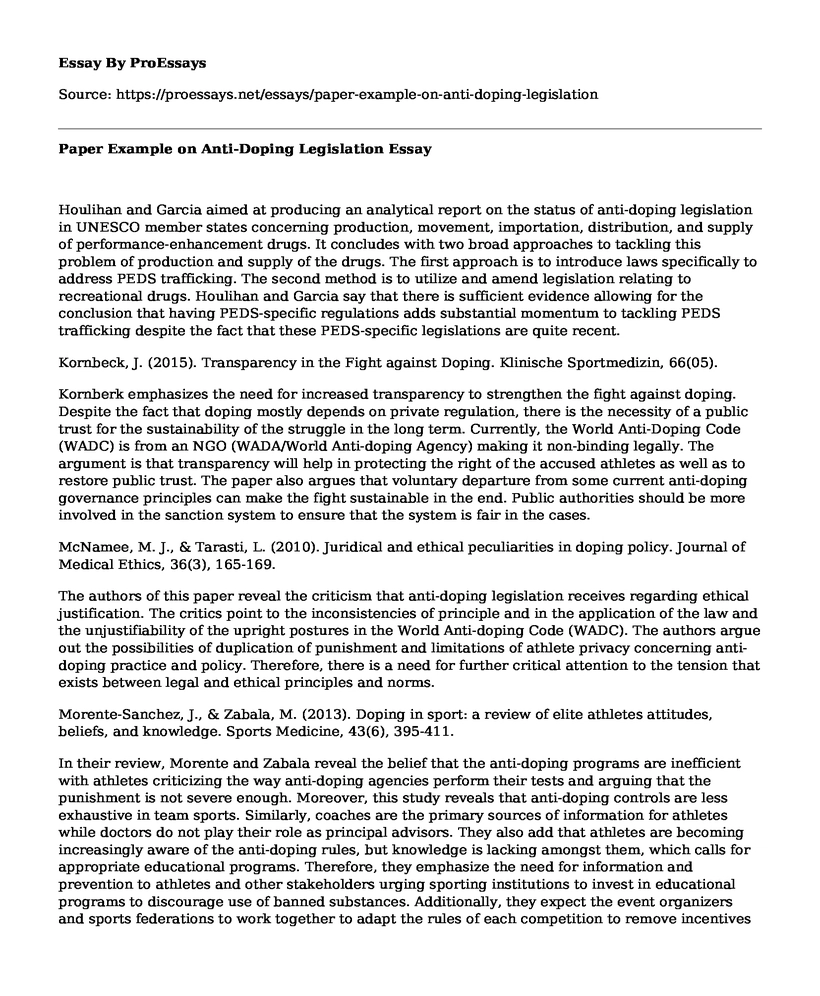Houlihan and Garcia aimed at producing an analytical report on the status of anti-doping legislation in UNESCO member states concerning production, movement, importation, distribution, and supply of performance-enhancement drugs. It concludes with two broad approaches to tackling this problem of production and supply of the drugs. The first approach is to introduce laws specifically to address PEDS trafficking. The second method is to utilize and amend legislation relating to recreational drugs. Houlihan and Garcia say that there is sufficient evidence allowing for the conclusion that having PEDS-specific regulations adds substantial momentum to tackling PEDS trafficking despite the fact that these PEDS-specific legislations are quite recent.
Kornbeck, J. (2015). Transparency in the Fight against Doping. Klinische Sportmedizin, 66(05).
Kornberk emphasizes the need for increased transparency to strengthen the fight against doping. Despite the fact that doping mostly depends on private regulation, there is the necessity of a public trust for the sustainability of the struggle in the long term. Currently, the World Anti-Doping Code (WADC) is from an NGO (WADA/World Anti-doping Agency) making it non-binding legally. The argument is that transparency will help in protecting the right of the accused athletes as well as to restore public trust. The paper also argues that voluntary departure from some current anti-doping governance principles can make the fight sustainable in the end. Public authorities should be more involved in the sanction system to ensure that the system is fair in the cases.
McNamee, M. J., & Tarasti, L. (2010). Juridical and ethical peculiarities in doping policy. Journal of Medical Ethics, 36(3), 165-169.
The authors of this paper reveal the criticism that anti-doping legislation receives regarding ethical justification. The critics point to the inconsistencies of principle and in the application of the law and the unjustifiability of the upright postures in the World Anti-doping Code (WADC). The authors argue out the possibilities of duplication of punishment and limitations of athlete privacy concerning anti-doping practice and policy. Therefore, there is a need for further critical attention to the tension that exists between legal and ethical principles and norms.
Morente-Sanchez, J., & Zabala, M. (2013). Doping in sport: a review of elite athletes attitudes, beliefs, and knowledge. Sports Medicine, 43(6), 395-411.
In their review, Morente and Zabala reveal the belief that the anti-doping programs are inefficient with athletes criticizing the way anti-doping agencies perform their tests and arguing that the punishment is not severe enough. Moreover, this study reveals that anti-doping controls are less exhaustive in team sports. Similarly, coaches are the primary sources of information for athletes while doctors do not play their role as principal advisors. They also add that athletes are becoming increasingly aware of the anti-doping rules, but knowledge is lacking amongst them, which calls for appropriate educational programs. Therefore, they emphasize the need for information and prevention to athletes and other stakeholders urging sporting institutions to invest in educational programs to discourage use of banned substances. Additionally, they expect the event organizers and sports federations to work together to adapt the rules of each competition to remove incentives for dopers.
References
Avois, L., Robinson, N., Saudan, C., Baume, N., Mangin, P., & Saugy, M. (2006). Central nervous system stimulants and sport practice. British journal of sports medicine, 40(suppl 1), i16-i20.
Backhouse, S. H., Collins, C., Defoort, Y., McNamee, M., Parkinson, A., Sauer, M., ... & Horta, L. (2014). Study on Doping Prevention: A map of Legal, Regulatory and Prevention Practice Provisions in EU 28.
Houlihan, B., & Garcia, B. (2012). The use of legislation in relation to controlling the production, movement, importation, distribution and supply of performance-enhancing drugs in sport (PEDS). August. Online available at.
Kornbeck, J. (2015). Transparency in the Fight against Doping. Klinische Sportmedizin, 66(05).
McNamee, M. J., & Tarasti, L. (2010). Juridical and ethical peculiarities in doping policy. Journal of Medical Ethics, 36(3), 165-169.
Morente-Sanchez, J., & Zabala, M. (2013). Doping in sport: a review of elite athletes attitudes, beliefs, and knowledge. Sports Medicine, 43(6), 395-411.
Cite this page
Paper Example on Anti-Doping Legislation. (2021, Mar 23). Retrieved from https://proessays.net/essays/paper-example-on-anti-doping-legislation
If you are the original author of this essay and no longer wish to have it published on the ProEssays website, please click below to request its removal:
- Goldberg v. Kelly (1970) Case Study Paper Example
- Race and the Criminal Justice System: Racial Profiling Essay Sample
- The Impact of the ACA and Obamacare on U.S. Citizens' Healthcare Knowledge - Essay Sample
- Essay on Right to Liberty & Equity: Ensuring Fair Living for All
- Capital Punishment: Lawful Death Penalty for Level One Criminal Offences - Essay Sample
- Essay on Aging Does Not Have to Be a Losing Battle: Exploring Changes in Mindset
- Free Essay Sample on Transgender Athletes in Sports: Pros and Cons







